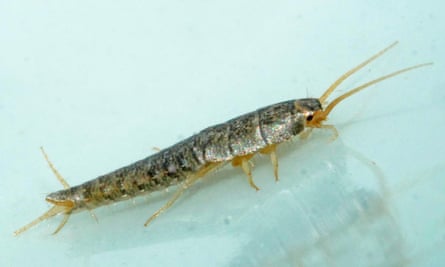I almost swilled a living fossil down the plughole when I showered this morning. Overnight, the tiny silverfish, Lepisma saccharina, had tumbled into the bath, a pitfall trap whose vertical sides were too smooth for it to escape.
It’s a while since I’ve encountered one of these ancient wingless insects, a survivor from the Devonian period that now lives among humans in the Anthropocene and still resembles its 400m-year-old fossil ancestors.
Silverfish thrive in cool, humid conditions, so modern centrally heated houses are a hostile environment, but they were a familiar sight during my 1950s childhood, in damp, dark corners of my grandmother’s house, heated with its single coal fire. They feed on carbohydrates, like spilled sugar and flour, so her larder (she had no refrigerator for food storage) was a good place to look for them. Lepisma is a fast mover, so catching one, as it zigzagged between cans and bottles, was challenging but the technique I learned as a child – coaxing it on to a sheet of paper and sliding it into a glass jar – served me well today.
In 1665, Robert Hooke, pioneer observer of the living world under a magnifying glass, waxed lyrical about these “small silver-colour’d book-worms”, describing how a “multitude of their reflecting scales, which from the multiplicity of their reflecting surfaces, make the whole animal appear of a perfect pearly-colour”. The engraving he produced, published in his Micrographia, is an astonishingly accurate depiction of a creature that rarely stands still, pursued by a scientist with an insatiable spirit of inquiry.

Anyone finding one of these little carrot-shaped insects, which roam while the household sleeps, might be tempted to just squash it, but they should follow Hooke’s example and take a close look. Under a hand lens I could see the shimmering, pearlescent scales that he so admired: what a wonderful fabric design they might make for a slinky dress to be worn on a Hollywood red carpet.
For silverfish, this coating of iridescent scales that slough off at the slightest touch is functional rather than decorative; there are spiders in our bathroom too, and that easily shed armour probably helps them to escape a predator’s jaws.

Comments (…)
Sign in or create your Guardian account to join the discussion